
-Shepherds in the background
-Mary and child are similarly presented as the Portinari Altarpiece
-The back corners have similar depictions or angels and shepherds as seen in Portinari Altarpiece
-Some of Bosch’s works are thematically similar to other Netherlandish pieces

-Figures are thin, faces are more simplified
-Golgatha (Bones underneath cross)
-Use of color is simplified
-Bosch stays away from elaborate patterns and drapery
-St. Peter depicted, not usually there

-Narrative scene
-People are given faces to characterize evil
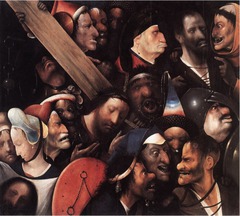
-Strange faces
-Innocence of Christ depicted
-Veronica is shown as a sweet character holding the cloth that wipes Christ’s face

-Thought to be a table cloth due to the position
-A large eyeball, “Beware, beware the lord sees”
-Pride of the artist is depicted, Bosch denotes artist like Jan van Eyck who have pride.
-4 last things are depicted outside the eyeball
-Death, Judgement, Heaven and Hell
-Superbia (Shows pride, woman is looking into the mirror. Has elements from the Arnolfini portraits, oranges, reflection, the woman’s headdress.
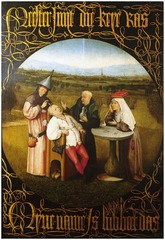
-An operation to remove rock from head
-The real pain is his wife cheating on him. Cuckold
-Image of foolishness
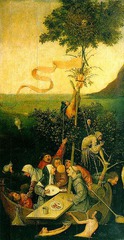
-Part of a triptych
– An allegory by the humanist Sebastian Brant, published in Basel in 1494
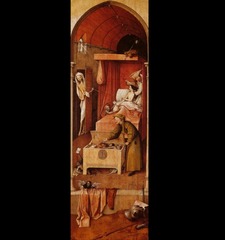
-Reminder to people to stay strong and go against temptations
-Angels urge the man to see Christ but the devil’s control his material fascination
-Shows what NOT to do to have a good death

-Grisaille
-Set up as if the Altarpiece is within an altarpiece (inception?)
-Complicating and though provoking
-Patron is in full color
-Gregory the Great kneeling

-Magi has symbols of the passion, crown of thrones around his neck
-Separation of sacred figure from chaos surrounding them. (This is traditional of Bosch)
-People peering from the inside are not Magi, but instead of onlookers of the scene
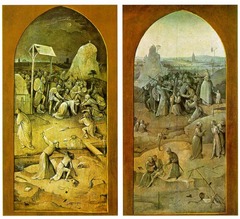
-Made of Grisaille
-Shows part of the Passion
-Stories being told parallel what’s going on inside interior
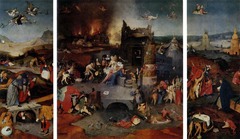
-St. Anthony is tormented by demons
– He is a hermit saint
-Priests and nuns are shown negatively, there is an animalization of them
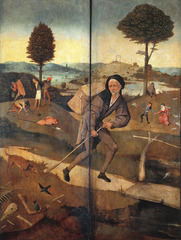
-Scenes of life being lived
-This is what is going on , on earth. Not always good and eventually leads to death
-Not necessarily last judgement
-Death comes to everyone, the man is following the road where temptation is abundant
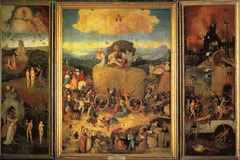
-Similar narrative to the Garden of Earth Delights
-Angels are being cast out of heaven also depicts Adam and Even being cast out of Paradise
-Hay contains multitudes of people depicting sins of the people
-Demons cart the hay away to the next panel containing hell
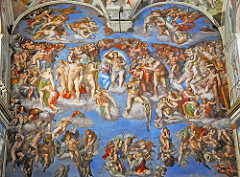
-St. Bavo on exterior giving alms to the poor
– The inside depicts the suffering and damnation of humans during the last judgement
-The left panel depicts adam and eve from creation to being cast out of paradise similar to lucifer being cast out of heaven
-The picture shows greed and gluttony and other carnal sins
-The final panel shows fall of punishment, Lucifer is shown judging the sinners himself, toads are a symbol of torture.
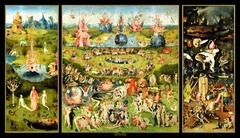
-Birds are signs of sexual activity, phallic
-You see birds in the water while fish are seen flying or on land going against their kind
-Emphasis on fruit and flowers comparing to indulgent consumption
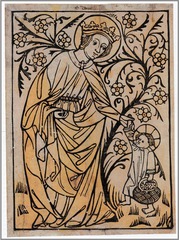
-Woodcuts were cheap and many didn’t last
-This piece was placed in a book and kept safe
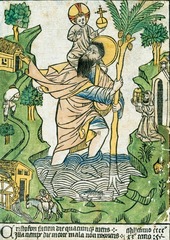
-More angular, different styles per regions
-Annoymous prints
-1000 prints per woodblock before they wear
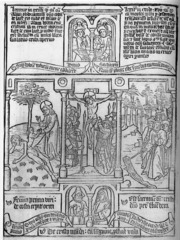
-Block book, single woodcut block
-Poor man’s bible
-Letters individually carved
-A way of lining up stories from old testament to new testament to show connection between old and new
-Mary undo’s what Eve did in the garden
-Prophets at bottom
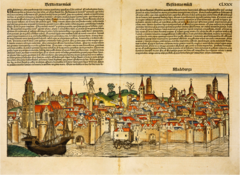
-History of the world
-Stars with creation, creation is upside down through the eyes of god
-Ends with the last judgement
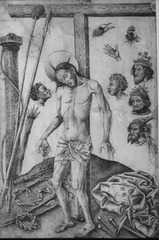
-Shows the mocking of Christ
-Engraving

-Engraving
-Earliest masterpiece of engraving
-Devotional images
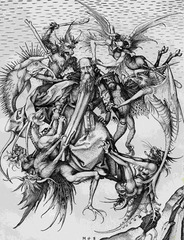
-Elaborate engraving
-Light manipulation textures
-Pictorial masterpiece
-Devils shown in mashup between insects and humans
-Engraving is a goldsmith technique
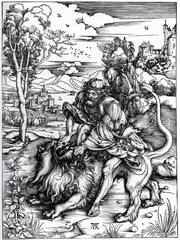
-Durer’s design
-Extremely elaborate
-Don’t know if Durer actually cut the block
-Looking at a professional block cutter
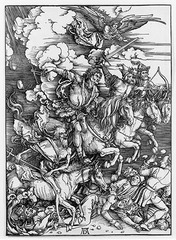
-Large block that would have had text
-St. John imagines the apocalypse
-Part of a series from Revelations
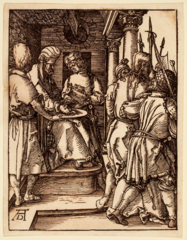
-There is more emphasis on the emotions and sufferings of Christ, less on landscape and background.
-It was meant to be more of a devotional work. It was his most popular work.
-Woodcut

-Engraving
-This print was made before his second trip to Italy
-He prints what might sell in Italy
-Models figures on sources that he thinks are ideal humans
-Animals represent blood (rabbit), phlegm (ox), black vile (Stag) and yellow vile (cat)
-It is in Latin so the print is more universal
-Snake has a crown on, carnal sin of pride
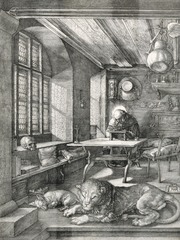
Engraving
-Lion is patron animal of St. Jerome
-Part of the 3 master prints
-St. Jerome represents the theological and contemplative life

Engraving
-Part of the 3 master prints
-Knight, Death and Devil represent moral virtue
-the rider is undistracted and true to his mission.

Engraving
-Part of the 3 master prints
Melancolia 1 represents intellectual sphere
-Representing the three spheres of activity recognized in medieval times
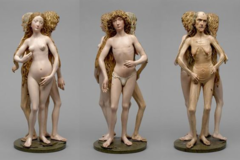
-You see a beautiful young woman and man and a contrasting old woman that symbolizes the decay the two teens will face
-Vanity and death are superimposed
-We are wrapped up in ourselves and don’t realize we can die at any moment
-made out of wood and painted
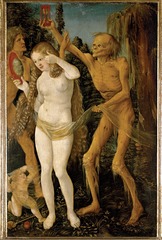
-You see the stages of life, from baby, young adult and old age all wrapped up in death’s hands
-Death can occur at any one of these stages
-The woman’s vanity keeps her ignorant to the fact that she could die at any moment

-Death has snuck up behind the woman
-Death is a terrifying sight, a contrast against a seemingly young and healthy woman
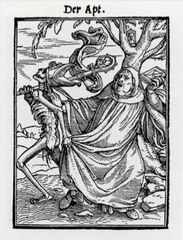
-Extremely popular work with 10 editions
-Shows ordinary people with different professions being visited by death at any given time
-Death comes to everybody even while doing ordinary tasks
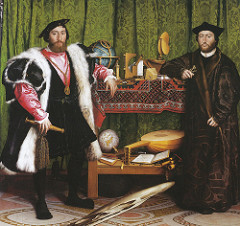
-Crucifix in the corner, while looking at the anamorphic skull your eyes are drawn to the crucifix in the corner
-When thing about death you begin to think about Christ
-Idea of death is present
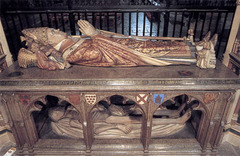
-Archbishop of Canterbury
-There is a contrast between his normal state as a person and a rotting decayed body underneath
-Shows that everyone will eventually decay no matter the way they lived their life
-The tomb was made before he died

-Depicts the sadness of Christ in the center surrounded by horrendous people
-He is being tortured and his pain is intensified instead of his innocence
-Expressionist work
-An emotional reaction is felt when looking at this piece
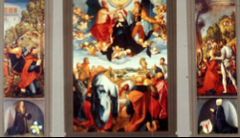
-Depicts the saints stacked
-Version of Grisaille
-It’s supposed to be a preliminary statement to the glorious interior
-They don’t look like statues
-Pleats show movement
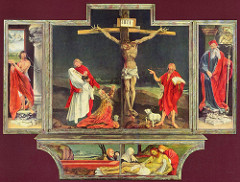
-Depicts crucifixion
-This piece was for patients suffering St. Anthony’s Fire, a disease that cause decay of skin and boils.
-It is found in a hospital chapel
-There was a strong connection between the patients and the picture as Jesus is suffering from the disease on the cross
-The Prudella slides apart his legs seem to be removed, as many of the patients with the disease lose limbs
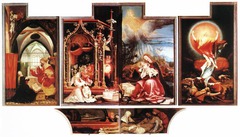
-Bright colors contrast morbid colors on the exterior
-There are 4 scenes depicted: Annunciation,
-Angel’s concert, Mary and Christ and the Resurrection of Christ
-Mary is reading the book of Isaiah and and Isaiah is seen in the corner foreshadowing the event
-Not a visually connected scene
-Basin refers to purity of Mary and they are sitting next to rose bushes that symbolize the rosary
-His body as lost the disease and his puncture wounds have turned to rubies.
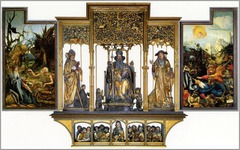
-Temptation of St. Anthony, being pulled apart by demons
-Demons are hybrids similar to Bosch’s representations of them
-Vividly imagined demons
-A man has St. Anthony’s fire and is slowly morphing into a demon himself
-The man has abandoned Christ and the inscription asks why

-Made with silver point
-Even at young age he mastered such a tricky form of drawing
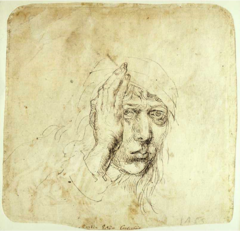
-Genuine study for himself
-Not concerned on precise details, but more on conveying emotions
-Shows how tricky it is to depict oneself while drawing oneself at the same time
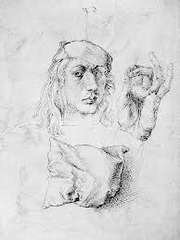
-He is studying and practicing and learning
-He is studying the folds of the pillow
-The pillows depict facial features
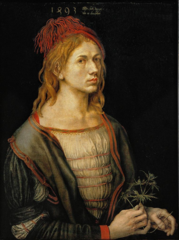
-He is holding Sea Holly, which means good luck
-This is a painting for his fiance
-The painting shows he isn’t quite thrilled for the marriage
-He looks sickly with bags under his eyes
-22 years old
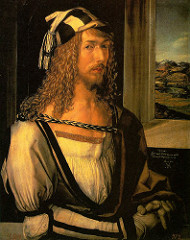
-He looks healthier
-Color scheme more unified
-Portrait convey’s his success
-He was a member of the wealthy merchants
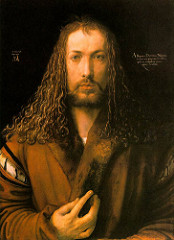
-Portrays himself as Jesus
Not blasphemous, artist are now trying to take credit for their work
-He is extremely idealized, making an image of posterity
-His hand is almost in the same position as the blessing hand of Christ
-He faces the looker face on unlike his previous self portraits

-Lovingly done, but ordinary and humbling
-Watercolor on paper
-Beautiful composition
-Have the character of a scientific illustration
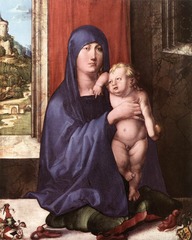
-Made after his return from Italy
-He uses concepts and compositions he learned in Italy
-Haller family of Nuremburg
-The back of the piece shows Lot and his children fleeing Sodom
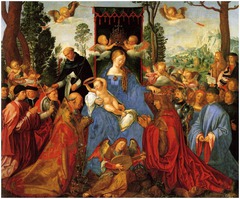
-Learned from Italy
-Hold figures in same space and community
-There are people and saints from the German community
-Durer is in the portrait
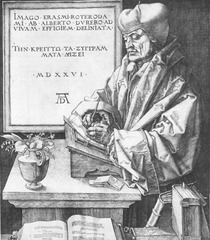
-Engraving
-Humanist Portrait
-Durer got to meet Erasmus
– Importance of humanism in Durer’s life
-“His writing will present a better image”
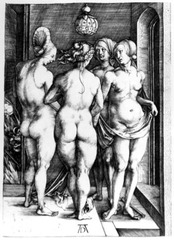
-Skull in background and demon in corner are signs of death
-Pomegranate above their head is a symbol for fertility
-They don’t seem like witches
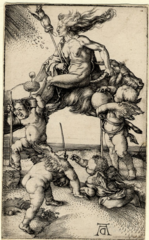
-Cupid symbolizes uncontrolled sexuality, god of love
-She is backwards because the world is turned upside down, things are not what how they should be
-Durer even goes as far as to invert his monogram to go along with the out of joint logic
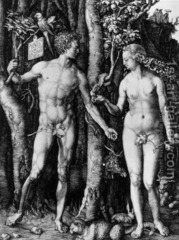
-Sharper definition of light and lines
-Baldung plaque is on the side similar to Durer’s
-There is only one sign of carnal sin and that is represented with the two rabbits (lust)
-Notion that sex is the reason for the fall of man
-Believed witches controlled the weather
-They were sexualized and placed in erotic positions

-Chiaroscuro Woodcut
-Colored paper is almost like painting
-Takes idea of sacred meal and turns it into a ceremony celebrating the devil
-Refers to Durer’s Witch Riding Backwards with a Broom
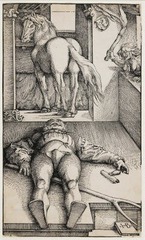
-People say he was kicked by the horse, his position say’s otherwise
-Horses are sexualized creatures
-Unicorn coat of arms
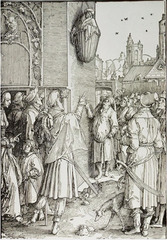
-Woodcut shows the act while engraving shows response
-Virgil gets tricked into climbing a basket and made fun of by August’s daughter
-Shows a woman’s triumph over man

-Shows the wiles of woman, woman’s power over man
-The man is distracted by her cleavage
– There is an erotic attraction between the two

-Deep space
-Makes the viewer search for the focal point
-Pilot is showing Christ to the people
-Jesus is not the main subject




